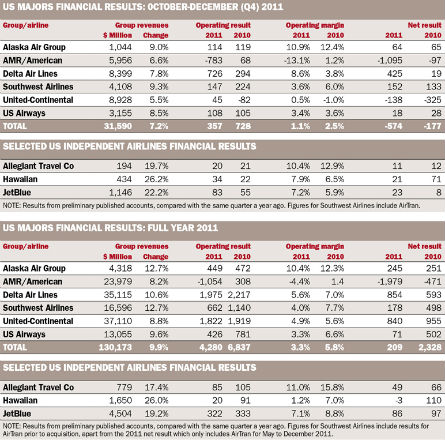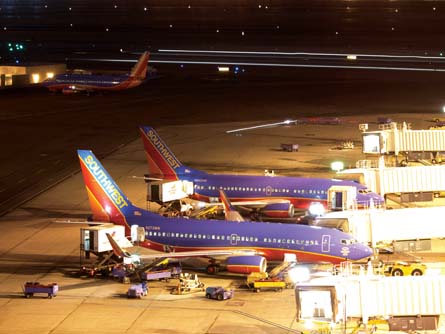Pages of a new playbook adopted by US carriers in the past few years are becoming well worn-in and results are promising, as capacity discipline and the abandonment of trying to gobble market share reap sustained returns.
Although levels of profitability varied, every US major carrier was profitable for 2011, with the exception of Chapter 11 restructuring American Airlines. All were profitable too in the fourth quarter, with the exception of United-Continental which was dragged down by special charges. Alaska, JetBlue and Southwest also posted quarterly and full-year profits.
All those airlines enjoyed profitability while battling stubbornly high fuel prices, with Delta boasting its revenue growth during the fourth quarter offset more than $500 million in higher fuel costs.
JetBlue, which lifted capacity by 10.5%, recorded the best fourth-quarter performance in its history, even though it paid $128 million more for fuel. An 11% rise in fares propelled passenger revenue per available seat mile (PRASM) 11.4% and helped yields grow 11.3%.
PRICING TRACTION
Pricing traction was a major factor in the industry's strong 2011 performance, but continuing the momentum could prove challenging in 2012. Both Delta and US Airways have warned year-on-year revenue comparisons will become tougher as the industry starts to lap numerous fare increases it enjoyed in 2011.
"There were a number of fare increases that were going through in rapid-fire succession at this time last year," says US Airways president Scott Kirby. He admits the double-digit monthly PRASM growth is likely to wane in 2012, but believes "very strong" high-digit growth should be sustainable throughout the year.
Kirby remains bullish in his belief the airline industry has avoided a beating from macroeconomic trends. "The fundamental demand environment remains strong," he declares.
Corporate travel also remained robust in 2011, as United-Continental recorded a 14% increase in corporate revenue for the year, while Delta's fourth-quarter revenues increased 15%.
 |
|---|
Carriers are confident corporate demand will remain stable this year. United-Continental chief revenue officer Jim Compton says recent discussions with the airline's corporate clients indicate 2012 these travel volume will be "flat to up", while travel spend will "moderately increase versus 2011".
After two years of sustained profitability, is the industry convinced past business plans have been trashed for good? The answer among chief executives is a resounding "yes". Highlighting industry performance against a backdrop of consistently high fuel prices, US Airways chief executive Doug Parker believes: "You'd be hard pressed to find businesses that have their highest cost component exactly the same where it was three years ago, but are producing margins that are 10 points higher than where they were three years ago. The economy hasn't driven that. We have transformed the business".
Delta is unrelenting in efforts to generate appropriate returns for shareholders after recording its most profitable fourth quarter in the company's history. "We are committed to permanently fixing our business model, and our 2010 and 2011 results show that our plan is working," says chief executive Richard Anderson.
Analysts at Raymond James believe the capacity discipline exhibited by the industry in 2008 to battle record fuel costs is a permanent fixture in the new playbook being used by airlines. "It appears that capacity control and, in turn, sustained high-unit revenue, may enable legacy carriers to retain and possibly grow earnings beyond the recovery high level. This is not something legacy carriers have been able to do in the past."
Capacity religion among most US carriers is taking on a new dimension as those airlines start to manage capacity from season-to-season and devise ways to smooth out peak-and-trough capacity.
SEASONAL ADJUSTMENTS
Late last year, Delta tabled a new strategy of seasonal adjustments to its capacity, outlining a 20-25% cut in supply during the fourth quarter of 2011 to the first quarter of 2012. Carrier president Ed Bastian declares: "We are bound and determined not to give back the money we make in the summer months."
Kirby concludes that US Airways, and the industry at large, are managing capacity during peaks and troughs differently these days. "We used to basically just run the same schedule seven days a week with a few cancellations on Saturday," he says. "We have much more variability in our schedules, and we fly a lot more capacity on peak days and in peak months than we did historically, and we fly less in the off-peaks. That is helping to raise load factors across the industry."
 |
|---|
Despite projections that strong demand trends should continue throughout 2012, airlines still face cost headwinds they are trying to meet head-on.
Delta has embarked on an initiative to cut its costs excluding fuel to 8.4 cents from a mid-2012 estimate of 8.8 cents. "Our biggest opportunity in 2012 is to improve our cost structure and effectively manage our fuel expense," says Anderson.
JetBlue admits it faces "significant challenges" in maintenance expense during 2012, as its fleet of Airbus A320s continues to age and the number of heavy C-checks and engine restorations increase. The airline estimates its unit costs excluding fuel should rise 2-5% in 2012.
"While we're taking steps to help offset some of this cost burden, including implementing a management hiring and salary freeze in 2012, we recognise we have more work to do on the cost front," admits JetBlue chief executive Dave Barger.
Cost-creep is a major concern for all carriers as most of them maintain flat-to-modest capacity increases for 2011. "Growth plays a major role in airline unit costs as it places downward pressure on the three largest components - fuel, labour and maintenance," Raymond James analysts say. "While capacity control is important, it will place greater pressure on carriers that are maintaining or contracting capacity."
Delta seems to understand the challenges associated with capacity discipline. "First, we will not use capacity to manage non-fuel unit costs," says Anderson. "Second, we showed in the December quarter with non-fuel cost per available seat mile below 2% on a 3.5% reduction in capacity that we can reduce our fixed cost as capacity is pulled. It just takes a bit of time."
Source: Airline Business























